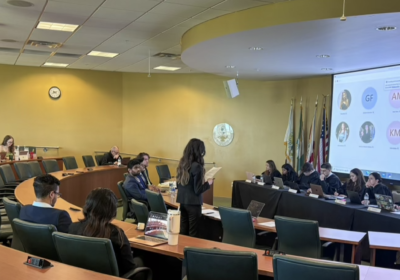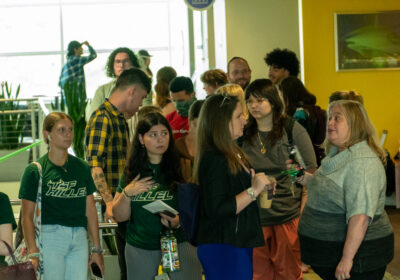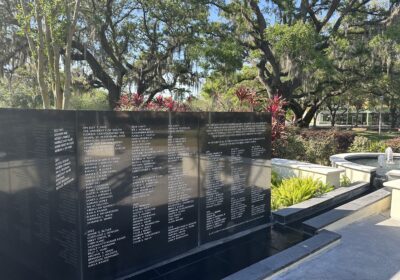The purple county

Republican presidential candidate Donald Trump and Democratic presidential candidate Hillary Clinton have both made multiple stops in Tampa during the course of their campaigns. ORACLE FILE PHOTOS/ADAM MATHIEU AND JACKIE BENITEZ
It’s almost an even split.
Within Hillsborough County’s 1,266 square miles live almost 850,000 registered voters: more than 335,000 democrats, more than 260,000 republicans and just fewer than 250,000 non-party affiliated.
Voting graphs of Hillsborough show a big blue middle with a healthy red rim and little bits of purple mixed in.
According to Gerri Kramer, director of communications for the Hillsborough County Supervisor of Elections, the county is the fourth-largest for population and voters registration and is very politically diverse, which is important when it comes to elections.
“So, when you look at how many (are) Democrats, Republicans and people who aren’t affiliated with a party, it’s pretty much split, so we’re considered very purple,” Kramer said.
Turnout has been good so far, Kramer said. Turnout to date refreshes every 10 minutes on the Hillsborough County Supervisor of Elections website. At the time of the interview, Kramer said about 36 percent of the county electorate had already voted.
More specifically, at the time of publication, combining early voting and vote by mail ballots, 113,183 Republican ballots, 131,771 Democratic ballots and 64,286 “other” ballots had been cast, according to the website.
Those numbers are set to keep climbing, as early voting doesn’t end until Sunday at 7 p.m. Then comes Election Day, which is on Nov. 8 this year.
The Presidential candidates and those campaigning for them have made multiple stops in Tampa on the campaign trail. Last week, Republican candidate Donald Trump came to the Florida State Fairgrounds. In February, he hosted a rally at the USF Sun Dome.
Democratic candidate Hillary Clinton has also visited Tampa and USF’s campus multiple times during the course of her campaign.
USF professor of political science Edwin Benton said he expects to see the candidates and those campaigning for them back in Tampa before Election Day. He doesn’t, however, think they’ll “put all of their eggs in one basket” by focusing on only a few metropolitan areas and instead will focus on the areas where they think they can sway voters.
“Hillsborough County has a little bit of everything and as a consequence, it can, depending upon the candidate and the issues in the election, go either way and so … it’s a key to how Florida may go as well, as well as what we know as the I-4 Corridor, which begins here and ends in Daytona Beach,” Benton said. “That area is very, very predictive of how the state goes (in) presidential elections for the last 20 years.”
Benton said he feels that the I-4 Corridor, which includes Tampa and other areas in Hillsborough, is a good reflection of what the electorate looks like nationwide. It serves as a microcosm of the state of Florida. Tampa, he said, is a bit bluer.
Friedemann Buschbeck, chair of the Tampa Green Party, is originally from Germany and was campaigning for Green Party candidate Jill Stein during Bull Market on Wednesday. He said a lot of decisions are made by voters along the I-4 Corridor.
“Because of the high number of electoral votes we can get, it is very attractive for any candidate,” Buschbeck said. “In order for a presidential candidate to win elections, we must win Florida.”
Buschbeck said the third party suddenly has a lot of power in the national election and he thinks the U.S. should adopt the multiparty system of Germany.
Megan Loos, a freshman majoring in psychology, has decided how she will cast her ballot Tuesday. The registered Republican will be voting for Trump, something she said she’s known for a long time. Trump was her pick in the Republican primaries.
Loos said she thinks it is better for undecided voters wait to decide because they are able to gather more information before they walk into the polls. She also said she thinks that the swing-county status is good.
“Then you have a lot of differences and you can hear other people’s opinions,” Loos said.
Savan Dave, vice president of College Democrats, expressed a similar sentiment on the mixing of opinions. He said he feels the mixture of different political perspectives allows for other voices and policies to enter the picture. He pointed to the democratic centers in the county as well as the republican “Florida heartland” full of working class people.
Dave said he feels there are many important ballot initiatives worth voting for aside from the presidency.
“If you’re not excited about the presidential candidates, still go out and vote,” he said.
Michael Rey, a sophomore majoring in public health, already voted for Clinton. He is a registered Democrat who had originally picked Sen. Bernie Sanders for the primary. His motto in voting for Clinton was “Stop Trump.”
“I didn’t see the use in writing (Sanders’) name in because I thought it’d be kind of useless to do a protest vote,” Rey said.
Rey said he thinks the party split in Hillsborough County is a good thing because it shows a relatively equal number of Democrats and Republicans, meaning the outcome is based on votes and not on majorities.
“And if that doesn’t inspire supporters to go to the polls then I don’t know what does,” Rey said.
Jarie Rawls, a junior majoring in mass communications, is a registered Democrat who also already voted for Clinton and formerly supported Sanders.
“I was a Bernie supporter at first but he didn’t win so now it’s Hillary,” Rawls said.
Rawls said she had decided to vote for Hillary long before she went to the polls. She and Rey said the vote for Clinton was an easy decision for them.
Registered Republican Ryan Wesolowski, a freshman majoring in psychology, said he hasn’t voted yet and plans to leave the presidential race box blank when he makes it to the polls. He doesn’t want to vote for president, he said, because he doesn’t think either of the candidates are good people. He said he will vote for the other initiatives on the ballot.
“I’m going to leave (the presidential election) up to America,” Wesolowski said.






